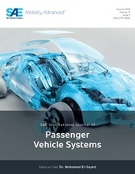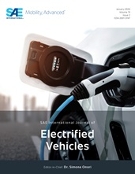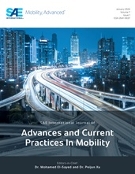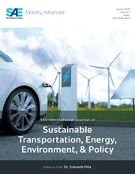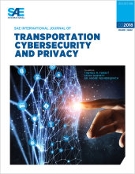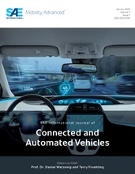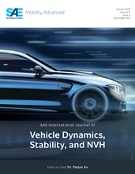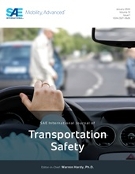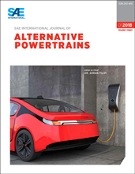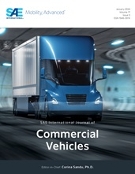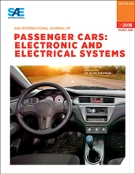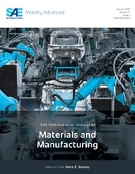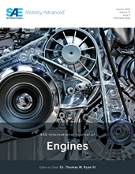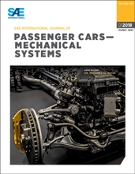Your Destination for Mobility Engineering Resources
Announcements for SAE Mobilus
Browse AllRecent SAE Edge™ Research Reports
Browse All 168Recently Published
Browse AllThis study evaluates the effectiveness of two hybrid computational aeroacoustic methods—Lighthill wave model and perturbed convective wave model—in simulating HVAC duct noise in the automotive industry. Using component-level acoustic testing of a Ford HVAC duct, simulations were conducted at varying airflow rates to assess the accuracy of both models in predicting duct noise. The Lighthill wave model, suitable for noise analysis in regions outside turbulent flow areas, showed a good correlation with experimental data, especially in the frequency range of 100 Hz–5000 Hz, but sometimes struggled with pseudo-noise effects at low frequencies near turbulent regions. The perturbed convective wave model, which is suitable for noise analysis anywhere in the flow domain, underpredicted sound pressure levels at low frequencies as well. Both models underpredicted high-frequency noise (>5 kHz) due to insufficient mesh and time-step sizes. Despite these limitations, the Lighthill wave model
This specification covers procedures for sampling and testing aircraft-quality, special aircraft-quality, and premium aircraft-quality steels requiring transverse tensile property testing.
This SAE Standard establishes terminology and the content of commercial literature specifications for self-propelled crawler and wheeled material handlers, pedestal mounted material handlers and their equipment as defined in 3.1. Illustrations used here are not intended to include all existing commercial machines or to be exactly descriptive of any particular machine. They have been provided to describe the principles to be used in applying this document. (Material handlers share many design characteristics with hydraulic excavators and log loaders; primarily 360 degree continuous rotation of the upperstructure relative to the undercarriage or mounting. They differ in their operating application. Material handlers are used for the handling of scrap material and normally utilize grapples or magnets. Hydraulic excavators are used for the excavation of earth, gravel and other loose material utilizing a bucket. Log loaders are used for the handling of logs and trees and normally utilize
This SAE Recommended Practice establishes consistent test procedures for determination of steady-state directional control properties for passenger cars and light trucks with two axles. These properties include the steering-wheel angle gradient, reference steer angle gradient, sideslip angle gradient, vehicle roll angle gradient, and steering-wheel torque gradient with respect to lateral acceleration. They also include the yaw velocity gain, lateral acceleration gain, and sideslip angle gain with respect to steering-wheel angle. Additionally, the characteristic or critical speed and the front and rear wheel steer compliances may be determined.
IEEE-1394b, Interface Requirements for Military and Aerospace Vehicle Applications, establishes the requirements for the use of IEEE Std 1394™-2008 as a data bus network in military and aerospace vehicles. The portion of IEEE Std 1394™-2008 standard used by AS5643 is referred to as IEEE-1394 Beta (formerly referred to as IEEE-1394b.) It defines the concept of operations and information flow on the network. As discussed in 1.4, this specification contains extensions/restrictions to “off-the-shelf” IEEE-1394 standards and assumes the reader already has a working knowledge of IEEE-1394. This document is referred to as the “base” specification, containing the generic requirements that specify data bus characteristics, data formats, and node operation. It is important to note that this specification is not designed to be stand-alone; several requirements leave the details to the implementations and delegate the actual implementation to be specified by the network architect/integrator for a
This SAE Standard provides a uniform method to calculate the lift capacity of scrap and material handlers, establishes definitions and specifies machine conditions for the calculations. This document applies to scrap and material handlers as defined in SAE J2506 that have a 360 degrees continuous rotating upper structure. It does not apply to equipment that is incapable of lifting a load completely off the ground. This document applies to those machines that are crawler, wheel, rail and pedestal or stationary mounted.
This SAE Aerospace Standard (AS) contains requirements for a digital time division command/response multiplex data bus, for use in systems integration that is functionally similar to MIL-STD-1553B with Notice 2 but with a star topology and some deleted functionality. Even with the use of this document, differences may exist between multiplex data buses in different system applications due to particular application requirements and the options allowed in this document. The system designer must recognize this fact and design the multiplex bus controller (BC) hardware and software to accommodate such differences. These designer selected options must exist to allow the necessary flexibility in the design of specific multiplex systems in order to provide for the control mechanism, architectural redundancy, degradation concept, and traffic patterns peculiar to the specific application requirements.
